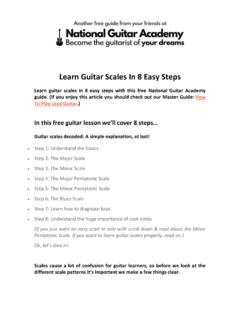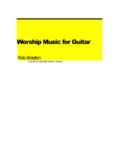Transcription of The C A G E D System Unlock your guitar
1 A Hobler 2008 1 The C A G E D System Unlock your guitar ! Guitarists have always sought to understand the instrument in a variety of ways. Many players use the C A G E D System without even being aware of it. It is considered to be a quite natural approach to learning the guitar and ex-panding the players knowledge of chords, scales and arpeggios in a logical and methodical way. Unless you have studied the guitar diligently for many years you will encounter many new concepts and musical tools in the following pages. Some chord shapes will be familiar while others you will rarely use. Keep an open mind though because once the basics are covered we will be manipulating these chords, arpeggios and scales into new and usable forms. The System works with 5 basic chord , scale and arpeggio shapes.
2 How you use them is up to you and/or your teacher but each shape should be learned thor-oughly. Also learn the names of the notes you are playing and the relationship of each note the chord . The numbers below each chord shape refer to this relationship. (See Theory Units1-5 if you are unclear on this.) Let s Unlock the CAGE! Chords in the 1st ish position E R 5 R 3 5 C R 3 5 R A R 5 R 3 G R 3 5 R 3 D R 5 A Hobler 2008 2 Notice that we have dropped off the two low strings on the G shape to facilitate easier fingering. These notes are still part of the chord and can be added in higher positions. Chords in the 3rd ish position C R 5 R 3 5 A 5 R 3 R G R 5 R 3 5 R D R 3 5 R 3 E R 5 R 3 A Shape G Shape E Shape D Shape C Shape * * Chords in the 5th ish Position 5 5 C R5 R 3 5 A 5 R 3 R G R 5 R 3 5 R D R 3 5 R 3 E R 5 R 3 G Shape E Shape D Shape C Shape A Shape 5 5 5 * A Hobler 2008 3 8 10 7 7 Chords in the 7th ish Position 7 C R 5 R 3 5 A 5 R 3 R G R 5 R 3 5 R D R 3 5 R 3 E R 5
3 R 3 E Shape D Shape C Shape A Shape G Shape 7 C A 5 R 3 R G D R 3 5 R 3 E D Shape C Shape A Shape G Shape E Shape R 5 R 3 5 R R 5 R 3 R 5 R 3 5 Chords in the 10th ish Position 9 10 10 10 A Hobler 2008 4 R 5 R 3 5 R R 3 5 R 3 R 5 R 3 5 5 R 3 R R 5 R 3 Chords in the 12th ish position E C A G D 12 12 12 12 12 Project Play C chord in all positions on the neck.
4 Take particular notice of where the root note is in each chord voicing. Do the same with A, G, E and D. Primary Chords in Each Key Each key has 3 primary chords that are built from the 1st 4th and 5th steps of the scale. The theory behind this beyond the scope of this book but you can get more detail and understanding by doing the exercises in most theory work-books. The table that follows shows the key and the primary chords that are used together in most songs. Key 1 4 5 C C F G G G C D D D G A A A D E E E A B B B E F# F# F# B C# F F Bb C Bb Bb Eb F Eb Eb Ab Bb Key 1 4 5 Ab Ab Db Eb Db Db Gb Ab Gb Gb Cb Db A Hobler 2008 5 These chords provide us with a perfect platform to work from in learning the basic chord positions for the CAGED System . You will also find that your rhythm guitar vocabulary will improve as you continue to use these chords.
5 We will approach the chord progressions by working with the keys of C A G E and D. Progression 1 4 C F G C 4 Play the chord progression using 1st position C chord , 1st po-sition F chord and 1st position G chord . Then do the same but play in 3rd position, then 5th etc. Progression 2 4 A D E A 4 Play the chord progression using 1st position A chord , 1st po-sition D chord and 1st position E chord . Then do the same but play in 2nd position, then 5th etc. Progression 3 4 G C D G 4 Play the chord progression using 1st position G chord , 1st po-sition C chord and 1st position D chord . Then do the same but play in 3rd position, then 5th etc. By now you will be seeing that the chord positions repeat even thought the actu-al chord names change. This is the real key to why this System works so well.
6 A Hobler 2008 6 Progression 4 4 E A B E 4 Play the chord progression using 1st position E chord , 1st po-sition A chord and 2nd position B chord . Then do the same but play in 3rd position, then 5th etc. Progression 5 4 D G A D 4 Play the chord progression using 1st position A chord , 1st po-sition D chord and 1st position E chord . Then do the same but play in 2nd position, then 5th etc. Now that the basic chord shapes are starting to make some sense and have a practical use, we need to move to the next phase of this System . This involves the arpeggios that are played in close proximity to the chord shapes. This is the end of CAGED Session 1






